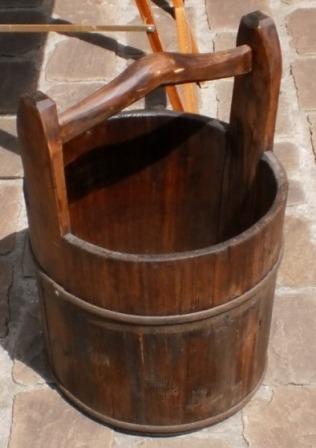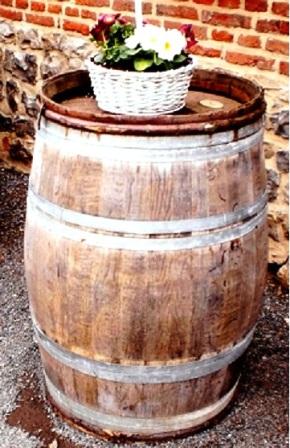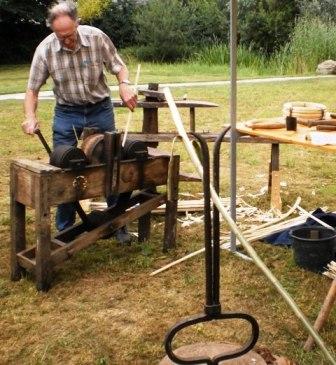 Containers can be made from wooden boards, woodstaves. Tubs are made of straight bars, tons of curved staves. For wine barrels mainly acacia, chestnut and oak were used.
Containers can be made from wooden boards, woodstaves. Tubs are made of straight bars, tons of curved staves. For wine barrels mainly acacia, chestnut and oak were used.
Only during the summer grows a tree. If cut in summer, growing timber contains more tannins and unwanted substances. So it is better to fell the tree in the fall or winter. The oak is only suitable for use as a construction material as it is ”seasoned” (dry, no longer wrapping and twisting). The humidity should decrease to 17-18 percent. This requires it to dry in the open air for three years.
“Many a tree is for life on earth more important than the man who cuts him down.”(Günther Schwab)
In Europe, the coopers were splitting the wood along the natural lines and veins. In the United States, it is common to cut the wood. Until the end of the 19th century (willow,..) reed hoops were used to hold the staves together, now that are iron strips.
The largest diameter of tank or vessel determines how much equal long and equal thick boards are needed. The width may vary. To make them properly fitting into a circular shape, the sides should be diagonally cut and planed. The desired angle you get by drawing 2 radius lines from of the center of a corresponding circle to the edge. If you fix two (wood or metal) slats scarce together, you can check the corners perfectly. Or with a compass to measure angles. For fixed recurring measurements there were also defined joint jigs. The cross-section of each stave therefore receives a trapezoidal shape. The cutting is done by fetching the staves on a fixed, reverse plane (like a jointer). It requires experience and patience to get every wood stave nice fitting (and waterproof).
 Tons have a spherical shape, they roll and steer easily, and with as little friction as possible. The curving also ensures molding tension and firmness. Tons get 6 (up to 8) hoops. To make the staves are bulging they are narrower at the tip. The conical taper of the stave is done with different kinds of planes. Where base and head have to be applied inside of the staves a slot is cut out. (Sometimes herein cane was led in order to gain the closure certainly waterproof.)
Tons have a spherical shape, they roll and steer easily, and with as little friction as possible. The curving also ensures molding tension and firmness. Tons get 6 (up to 8) hoops. To make the staves are bulging they are narrower at the tip. The conical taper of the stave is done with different kinds of planes. Where base and head have to be applied inside of the staves a slot is cut out. (Sometimes herein cane was led in order to gain the closure certainly waterproof.)
In the bending the staves were planed a quarter thinner with an in-shave.
The widest stave is less eroded, and got a bung hole.
To bend a wooden hoop a thick willow branch was put in water for a few days, split in 2 or 3 and turned through a wooden roller to fold.
Iron strips are cut to size. The iron bands around the barrels had to be "chased" by the children several times a day in the summer: beaten more firmly, because of the heat they loosely. To follow the conical shape of the barrel the inside where the hoop is broader must be cold hammered. Thereafter, the heads are punched and riveted, and the difference in thickness of the overlap at the inner side hammered equal so that the hoop -fastening will fit everywhere around the barrel. Coopers usually have hoops of different sizes, sometimes also available adjustable hoops.
For the construction of the barrel the staves are clamped in the upper ring structure. Subsequently, all of the following staves are pressed against the previous one. Down on the (flat!) floor they are so much wider open. The last stave is the hardest to place. Sometimes that needs to be refined. If it fails, the barrel falls apart. And you have to start again.
Thereafter, the 2nd and the 3rd ring are placed.
In this (half) barrel a fire of plane waste is fired in a basket. The staves are moistened on the inside. The heat shrink the shelves on the inside and will crook them. (Boiling or steaming the wood to fold would also.) After 15' and 120⁰C the wood is ready to bend.
The combustion (wood, duration) or toasting is decisive for the taste.
 The bending of the clapboards was done by folding a thick rope around it, and fastening it with a stick. There are various kinds of clamps with ropes around the barrel which can be tightened in order to draw the staves against each other with levers. With a hoop driver, the following hoops are hammered down. Who are on the inside chalked to avoid to come up again with a knock on the other side of the ring.
The bending of the clapboards was done by folding a thick rope around it, and fastening it with a stick. There are various kinds of clamps with ropes around the barrel which can be tightened in order to draw the staves against each other with levers. With a hoop driver, the following hoops are hammered down. Who are on the inside chalked to avoid to come up again with a knock on the other side of the ring.
The heavy ash wood or steel structure hoops (to draw the staves together) are later replaced by iron string.
Making the inside smooth with the bow plane and the exterior clean by sanding is the last work on the barrel.
With moisture in the barrel the gaps were closed by swelling themselves.
